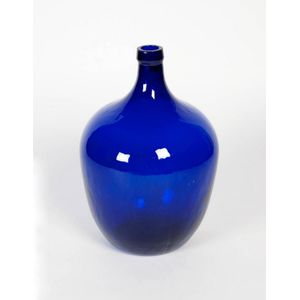Royal Doulton Flambe Veined Vase
A Royal Doulton bone china 'Flambe Veined' vase, post 1928 mark, model 1616, the high shouldered ovoid vase with a small neck, decorated to the collar, with thread like flames of red upon a purple and blue ground, the lower, register thickly pock marked with orange marks on a blue fading to turquoise, ground, backstamp underside and model number, height 22.5 cm
You must be a subscriber, and be logged in to view price and dealer details.
Subscribe Now to view actual auction price for this item
When you subscribe, you have the option of setting the currency in which to display prices to $Au, $US, $NZ or Stg.
This item has been sold, and the description, image and price are for reference purposes only.
- Oviform /ovoid - The outline loosely resembling the shape of an egg.
- Bone China - Bone china, Also called 'English china", is one of the three types of porcelain, the other two being soft paste porcelain and hard paste porcelain.
Porcelain is an ancient ceramic material, first made in China, hence the common name "china", and the introduction of bone china was to counter the imports of Chinese porcelain.
The initial development of bone china is credited to Josiah Spode, who introduced it around 1800 and it was soon after copied by other manufacturers including Minton, Coalport, Davenport, Derby, Worcester, Wedgwood and Rockingham and the Herculaneum factory at Liverpool.
Spode's bone china was made by mixing ash from cattle bones with feldspar and kaolin, which created a material that was stronger, more translucent, and whiter than traditional porcelain. He began to produce this new type of porcelain in 1796 and it quickly became very popular.
At the time, the process and ingredients were kept secret and were only known to a few manufacturers and were protected by patents.
In the 19th century, bone china became increasingly popular and was widely produced by many manufacturers in England. During this time, it was considered a luxury item and was often used to create fine dining sets and other decorative items.
Bone china is still used in the production of fine porcelain wares, such as tea sets, figurines, and other decorative pieces. His basic formula of six parts bone ash, four parts china stone, and three and a half parts china clay remains the standard English body. It is still considered a luxury item due to its strength, translucency, and whiteness, and is often used for high-end and high-quality porcelain. China.
This item has been included into following indexes:
- Royal Doulton (England), item types
Visually similar items

A large cobalt blue carboy, French 19th century. 60 cm high, approx. 46 cm diameter
Sold by
in
for
You can display prices in $Au, $US, $NZ or Stg.

Large Royal Doulton 'Flambe Viened' vase, of handsome proportions, with baluster body, decorated with black swirls on a red ground,
Sold by
in
for
You can display prices in $Au, $US, $NZ or Stg.

A cobalt blue carboy, French 19th century, approx. 52 cm high, 32 cm wide
Sold by
in
for
You can display prices in $Au, $US, $NZ or Stg.

Royal Doulton Flambe veined vase, #1618, 24 cm high approx
Sold by
in
for
You can display prices in $Au, $US, $NZ or Stg.
